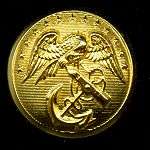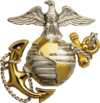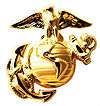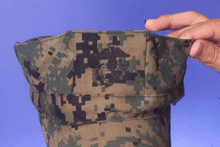Eagle, Globe, and Anchor
The Eagle, Globe, and Anchor is the official emblem and insignia of the United States Marine Corps. It is commonly referred to as an EGA, although this usage is officially discouraged by the U.S. Marine Corps.[1] The current emblem traces its roots in the designs and ornaments of the early Continental Marines as well as the United Kingdom's Royal Marines. The present emblem, adopted in 1955, differs from the emblem of 1868 only by a change in the eagle. Before that time many devices, ornaments, ribbons, and distinguishing marks followed one another as official badges of the corps.
History



In 1776, the device consisted of a fouled anchor (tangled in its rope) of silver or pewter. Changes were made in 1798, 1821, and 1824. In 1834, it was prescribed that a brass eagle be worn on the cover, the eagle to measure 3.5 inches (89 mm) from wingtip to wingtip. An eagle clutching a fouled anchor with thirteen six-pointed stars above was used on uniform buttons starting in 1804.[2] This same insignia is used today on the buttons of Marine dress and service uniforms, with the six-pointed stars changed to five-pointed stars.[2]
During the early years numerous distinguishing marks were prescribed, including "black cockades", "scarlet plumes", and "yellow bands and tassels". In 1859, the first version of the present color scheme for the officer's dress uniform insignia appeared on an elaborate device of solid white metal and yellow metal. The design included a United States shield, half wreath, a bugle, and the letter "M."
In 1868, the Commandant, Brigadier General Jacob Zeilin, appointed a board "to decide and report upon the various devices of cap ornaments of the Marine Corps." On November 13, 1868, the board recommended the modern insignia. It was approved by the commandant four days later, and by the Secretary of the Navy on November 19, 1868.
Design and symbolism



The emblem recommended by the 1868 board consisted of a globe (showing the continents of the Western Hemisphere) intersected by a fouled anchor, and surmounted by a spread eagle. On the emblem itself, there is a ribbon, clasped in the eagle's beak, bearing the Latin motto "Semper Fidelis" (English: Ever Faithful). The uniform insignias omit the motto ribbon.
The general design of the emblem was probably derived from the Royal Marines' "Globe and Laurel."[3] The globe on the U.S. Marine emblem signifies the Corps' readiness to service in any part of the world. The eagle represents the United States. The anchor, which dates back to the founding of the corps in 1775, acknowledges the naval tradition of the Marines and their continual service within the Department of the Navy.
There are some differences between the uniform insignia for enlisted marines and that of officers: The enlisted Marines' dress blue uniform insignia is die-struck from a single sheet of brass and annodized a gold color. The service uniform insignia is coated a flat black color.
The officers' insignia is assembled from four parts: a die-struck silver colored globe with eagle, and gold colored anchor with silver colored fouling rope, and gold colored continents.
Current emblem and seal

In 1954, the Commandant, General Lemuel C. Shepherd, Jr., requested the design of an official seal for the corps.
The new seal included the traditional Eagle, Globe, and Anchor emblem in gold, with the Globe and anchor rope in silver. The eagle is depicted with wings displayed, standing upon the western hemisphere of the terrestrial globe, and holding in his beak a white ribbon bearing the Marine Corps motto "Semper Fidelis" (Always Faithful) with the hemisphere superimposed on a fouled anchor. An American bald eagle replaced the crested eagle depicted on the 1868 emblem.
The emblem is displayed on a scarlet background encircled with a blue band bearing the phrases "Department of the Navy" above and "United States Marine Corps" below in white letters, the whole edged in a gold rope
U.S. President Eisenhower approved the design on June 22, 1954. The emblem as shown on the seal was adopted in 1955 as the official Marine Corps emblem.
See also
- Flag of the United States Marine Corps
- History of the United States Marine Corps
- Henry Clay Cochrane
References
![]() This article incorporates public domain material from websites or documents of the United States Marine Corps.
This article incorporates public domain material from websites or documents of the United States Marine Corps.
- ↑ "FAQ: What is the origin of the eagle, globe and anchor?". Leatherneck - Magazine of the Marines. Archived from the original on 2008-05-02. Retrieved 2008-05-10.
Always referred to as the Marine Corps emblem and never as the 'EGA...'
- 1 2 Smith, Charles Richard; Waterhouse, Charles H. (1975). A Pictoral History: the Marines in the Revolution (PDF). United States Marine Corps Historical Division. Retrieved 2008-08-22.
- ↑ "Customs and Traditions: Marine Corps Emblem and Seal". History Division, United States Marine Corps. Retrieved 2007-09-01.
Further reading
- Driscoll, Col John A. (1971). The Eagle, Globe, and Anchor: 1868-1968 (PDF). Washington, D.C.: History & Museums Division.
- "Customs and Traditions: Marine Corps Emblem and Seal". History Division, United States Marine Corps. Retrieved 2007-09-01.
- "FAQ: What is the origin of the eagle, globe and anchor?". Leatherneck - Magazine of the Marines. Archived from the original on 2008-05-02. Retrieved 2008-05-10.
